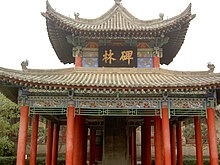National academy of east Asian empires
 Biyong, the imperial lecture hall in Beijing Guozijian
Biyong, the imperial lecture hall in Beijing Guozijian
 The imperial lecture hall and classrooms in Beijing Guozijian
The imperial lecture hall and classrooms in Beijing Guozijian
 Juniperus chinensis from Six Dynasties
, the symbol of Nanjing Guozijian
Juniperus chinensis from Six Dynasties
, the symbol of Nanjing Guozijian
 Stele Forest
in
Xi'an
, where collects many ancient steles from
Chang'an
Guozijian of the
Tang dynasty
Stele Forest
in
Xi'an
, where collects many ancient steles from
Chang'an
Guozijian of the
Tang dynasty
The
Guozijian
,
[1]
sometimes translated as the
Imperial College
,
Imperial Academy
,
Imperial University
,
National Academy
, or
National University
,
[2]
was the national central institution of higher learning in
Chinese dynasties
after the
Sui dynasty
. It was the highest institution of academic research and learning in
China
's traditional educational system, with the function of administration of education.
History
[
edit
]
Formerly it was called the
Taixue
(
lit.
'
Imperial University
'
). The Taixue for Gongsheng (
tribute students
) from the populace was part of the Guozijian, along with Guozixue for noble students. The central schools of the Taixue were established as far back as 3 CE, when a standard nationwide school system was established and funded during the reign of
Emperor Ping of Han
.
[3]
The institution was known as the Guozijian beginning in the
Sui dynasty
. During the
Ming dynasty
, the
Hongwu Emperor
promoted the study of
law
,
math
,
calligraphy
,
equestrianism
, and
archery
at the Guozijian.
[4]
In 1905, the Guozijian was shut down. During the
1898 reform
of the
Qing dynasty
, the education and administrational functions of the Guozijian were mainly replaced by the Imperial Capital University (also translated as Imperial University of Peking), which later became the modern
Peking University
.
Locations
[
edit
]
Guozijian were located in the national capital of each Chinese dynasty, such as
Chang'an
,
Luoyang
,
Kaifeng
, and
Hangzhou
. In early years of the Ming, the Guozijian was in
Nanjing
. Afterwards, the Ming had two capitals, so there were two Guozijian:
one in Nanjing
(which later became
Nanjing University
) and one in
Beijing
. During the
Qing dynasty
, the Guozijian was in Beijing.
The
Beijing Guozijian
, located on
Guozijian Street
in the
Dongcheng District
, was the imperial college during the
Yuan
, Ming, and Qing dynasties; most of the current buildings were built during the Ming dynasty.
[5]
It was the last Guozijian in China and the predecessor of
Peking University
.
Vietnam
[
edit
]
 Entrance of the imperial academy in Hu?, central Vietnam
Entrance of the imperial academy in Hu?, central Vietnam
 Altar to Chu V?n An, rector of the imperial academy.
Altar to Chu V?n An, rector of the imperial academy.
In Vietnam, a year after the first
Confucian examinations
established by
Ly Nhan Tong
(李仁宗), the Guozijian (
Vietnamese
:
Qu?c t? giam
,
ch? Han
: 國子監) was built in 1076 on the site of the
Temple of Literature
.
[6]
It was Vietnam's first university, it lasted from 1076 to 1779. In 1802, the Nguy?n dynasty founded the Hu? capital where they established a new imperial academy in the new capital. Several notable rectors of the Qu?c t? giam in
Hanoi
were
Chu V?n An
,
Nguy?n Phi Khanh
, and
V? Mien
.
See also
[
edit
]
References
[
edit
]
Citations
[
edit
]
Sources
[
edit
]
- Chang, Che-chia. "The Qing Imperial Academy of Medicine: Its institutions and the physicians shaped by them."
East Asian Science, Technology, and Medicine
41.1 (2015): 63?92.
online
- Sivin, Nathan. "Science and Medicine in Imperial China--the state of the field."
Journal of Asian Studies
(1988): 41?90.
online
- Yuan, Zheng. "Local Government Schools in Sung China: A Reassessment,"
History of Education Quarterly
(Volume 34, Number 2; Summer 1994): 193–213.
|
|---|
| Nobility
| |
|---|
| Offices
| |
|---|
| Institutions
| |
|---|
| Early Imperial
| |
|---|
| Middle Imperial
|
|
|---|
| Late Imperial
|
|
|---|
| Imperial guards
| |
|---|
| Dynasties
| |
|---|